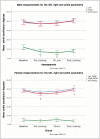Is ankle taping effective to limit the ankle dorsiflexion in a single-training session? An observational study in semi-professional basketball players
- PMID: 37531479
- PMCID: PMC10393384
- DOI: 10.1590/1516-3180.2022.0578.R1.06032023
Is ankle taping effective to limit the ankle dorsiflexion in a single-training session? An observational study in semi-professional basketball players
Abstract
Background: Ankle taping (AT) is effective in preventing ankle sprain injuries in most common sports and is employed in rehabilitation and prevention sports.
Objective: This study aimed to investigate the effectiveness of AT to restricting excessive frontal plane ankle movements in semi-professional basketball players throughout the training session.
Design and setting: A cross-sectional study was performed at the Universidad Europea de Madrid.
Methods: Forty male and female semi-professional basketball players were divided into two groups. The ankle dorsiflexion range of motion (ROM) and interlimb asymmetries in a weight-bearing lunge position were evaluated at four time points: 1) with no tape, 2) before practice, at 30 min of practice, and 3) immediately after practice.
Results: In male basketball players, no differences were observed in the right and left ankles between the baseline and 30 min and between baseline and 90 min of assessment. In female athletes, significant differences were reported between baseline and pre-training assessments for the right ankle and also significant differences between baseline and 90 min in both ankles.
Conclusions: Ankle taping effectively decreased the ankle dorsiflexion ROM in male and female basketball players immediately after application. However, ROM restriction was very low after 30 and 90 min, as assessed in a single basketball practice. Therefore, the classic taping method should be revised to develop new prophylactic approaches, such as the implementation of semi-rigid bracing techniques or the addition of active stripes during training or game pauses.
Conflict of interest statement
Figures
Similar articles
-
Effects of basketball match-play on ankle dorsiflexion range of motion and vertical jump performance in semi-professional players.J Sports Med Phys Fitness. 2020 Jan;60(1):110-118. doi: 10.23736/S0022-4707.19.09918-3. Epub 2019 Oct 16. J Sports Med Phys Fitness. 2020. PMID: 31640316
-
Effectiveness of Warm-Up Routine on the Ankle Injuries Prevention in Young Female Basketball Players: A Randomized Controlled Trial.Medicina (Kaunas). 2019 Oct 16;55(10):690. doi: 10.3390/medicina55100690. Medicina (Kaunas). 2019. PMID: 31623096 Free PMC article. Clinical Trial.
-
Effect of prophylactic ankle taping on ankle and knee biomechanics during basketball-specific tasks in females.Phys Ther Sport. 2018 Jul;32:200-206. doi: 10.1016/j.ptsp.2018.04.006. Epub 2018 Apr 8. Phys Ther Sport. 2018. PMID: 29803127
-
Acute Ankle Sprain in Elite Athletes: How to Get Them Back to the Game?Foot Ankle Clin. 2023 Jun;28(2):309-320. doi: 10.1016/j.fcl.2022.12.007. Epub 2023 Mar 1. Foot Ankle Clin. 2023. PMID: 37137625 Review.
-
The effect of tape, braces and shoes on ankle range of motion.Sports Med. 2001;31(9):667-77. doi: 10.2165/00007256-200131090-00003. Sports Med. 2001. PMID: 11508522 Review.
Cited by
-
Beyond support: exploring the dynamic and static biomechanical changes induced by preventive ankle taping: a novel cross-sectional study.PeerJ. 2025 Jan 27;13:e18472. doi: 10.7717/peerj.18472. eCollection 2025. PeerJ. 2025. PMID: 39886021 Free PMC article.
References
Publication types
MeSH terms
LinkOut - more resources
Full Text Sources


